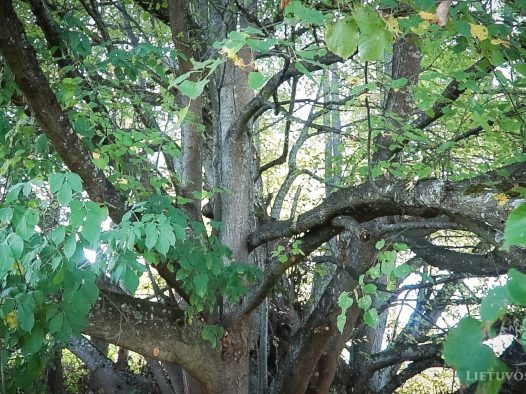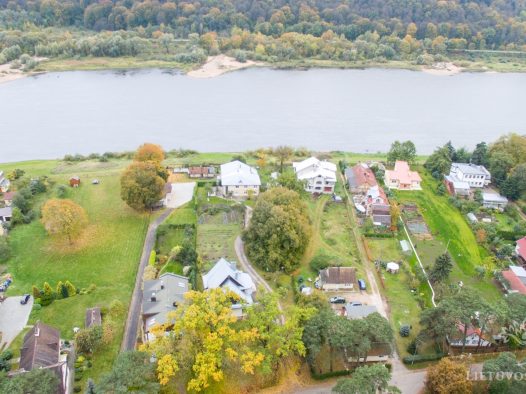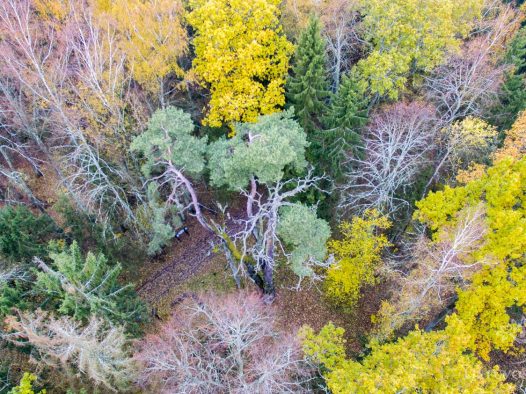Lithuanians have loved and cherished their woods from the ancient times, and centenarian trees they considered to be sacred. The respect towards the mighty oaks, ash trees, lime trees and pine trees can be felt nowadays as well.
Centenarian Lithuanian trees – natural riches preserved by people
Approximately 250 trees in Lithuanian have been acknowledged as protected natural monuments. Among them is one of the oldest trees in Europe – Stelmužė Oak. No one knows the exact age of the old one; however, the guess is that it is more than a thousand years old. Though some scientists claim that the oak might be twice that age. The stem of the mighty one standing in Zarasai district reaches 13 metres, and it needs 10 sturdy men to encircle it. This tree is considered to be a symbol of all Lithuanian oaks. Even the little trees grown from its acorns are being protected. They are called Stelmužiukai in the honour of the old one, and are being planted all over Lithuania.
Another mighty oak grows in Plungė district. Mingėla Oak is already counting hundreds of years; however, its exact age is also unknown. Historians claim that in the 15th century, when Christianity was being introduced in the territory of Lithuania, the sacred oak trees used to be massively destroyed due to their value to the faith of the Baltic tribes. It’s quite possible that Mingėla Oak narrowly escaped the sad fate that befallen his brothers. The locals tell a legend how crusaders supposedly ordered to cut down the oak but no one dared to do this. Eventually, one villager named Mingėla agreed to take up the task for a reward. But even he shook in his shoes, so he was able to cut off only the top of the tree. Later on the locals drowned the sell-out Mingėla in the river Minija for the damage done to the sacred tree.
There is a reason why Lithuanians respected and safeguarded oaks. They used to be considered to be the trees of the most powerful Baltic god – Perkūnas. Pagan priests used to perform essential rituals under the oaks, and priestesses used to keep the sacred fire near them. Oak used to be associated with the male power, strength, stamina and wisdom. The old custom says that when the son is born the family had to plant an oak, and when a girl is born – a lime tree.
Lime trees used to be considered as the trees of the goddess of fate Laima, and used to be associated with the female fertility, beauty and youth. Just as hundreds of years ago, Lithuanian women take linden sauna whisks to saunas even now. Lime trees are being widely applied in Lithuanian folk medicine as well. Tea, stimulating perspiration and healing cough and cold, is made from lime blossoms.
It’s believed that the oldest and the thickest lime tree in Lithuania grows in the district of Kaunas, in the village of Braziukai. A tree of approximately 3-4 hundreds of years is affectionately called a Mother Linden. The locals say that in the middle of the 19th century insurgents used to gather by the lime tree, who found the shelter in the lime tree hole. 7 grown men supposedly used to fit into the tree hole.
Another lime tree growing in Kaunas district, Lampėdžiai, is called by honorific title – Lime the Beauty of Lampėdžiai. The stem of the lime tree of two and a half hundred years old is split into four parts, and widely spread out branches and leaves make an impressive crown of 22 metres. It’s been said that this lime tree is supposedly compiled of five lime trees once planted side by side which have grown into one stem, though the top of it still equals the majesty of five lime trees.
If lime trees and oaks have been associated with the great Baltic gods from the ancient times, conifer trees had a less honourable fate. Ancestors used to associate pine tree and spruce with witches and other wicked beings. Spruce used to be considered as the tree of death and misfortune. A custom from those times has remained to spread the twigs of a spruce on the threshold of the house where a diseased person is laid out and to adorn the graves with the twigs of a spruce.
One of the most interesting spruces grows in Žemaitija National Park, in the forest of Plokščiai. This tree is called Spruce the Crone due its weird form. If you take a good look, a thick and knobby stem of the spruce reminds of a fat hump-backed crone. And in the district of Kaunas, in Rumšiškės, there is the thickest Lithuanian pine tree. Its stem reaches 4 meters, and the stipulated age of it is approximately 200 years.
Other centenarian trees of Lithuania are no less impressive: poplars, ash trees, chestnut, and larches. You can learn more about them on the website www.lietuvosgamta.lt. Here you will find unique photos of trees and will be able to listen to the audio guide stories as well as watch video films about Lithuanian trees. Moreover, the website will provide you information about other curiosities of Lithuanian nature and you will be able to find them easily by using provided coordinates and maps.



































